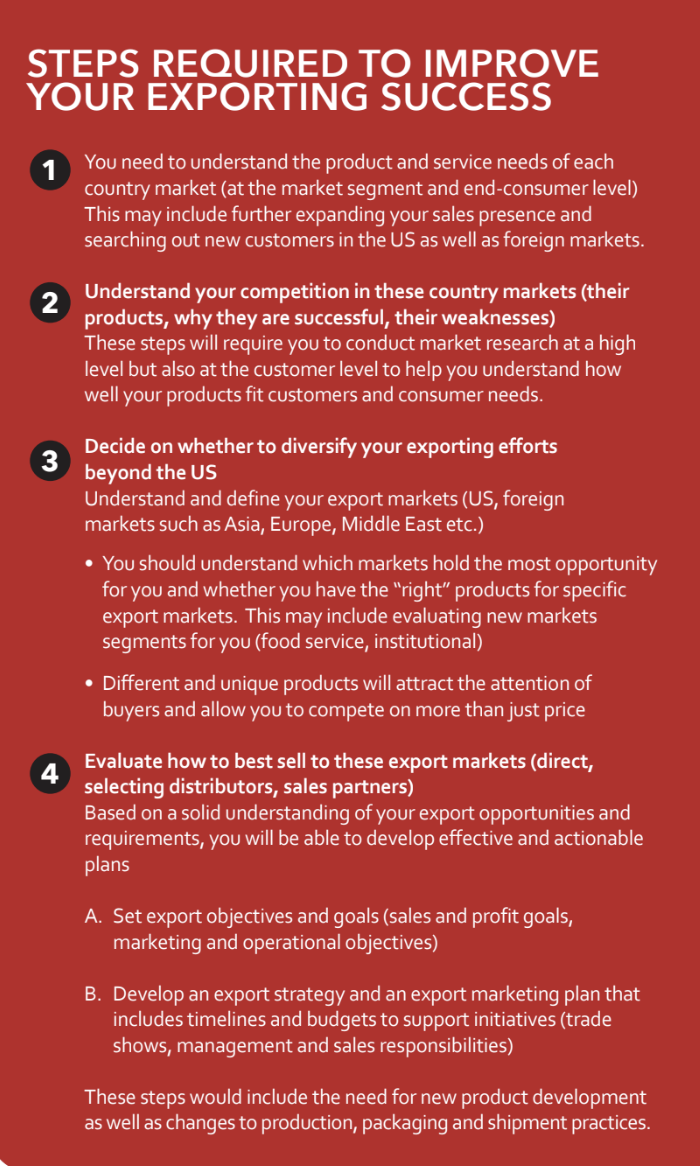High US Tariffs on
Canadian Food Exports?
*Click here to see the published article
Written by: Douglas Hart, President of Hart & Associates
Published by: Western Food Processing Magazine
It’s Time to Get Serious About Exporting!
Prior to his inauguration, US President Trump announced intentions to impose major tariffs on Canadian exports to the US. By the time this article is published, President Trump may have removed some or all of these tariffs in return for border and immigration agreements, or perhaps not.
The threatened 25% tariff on Canadian exports to the US would cause major disruptions to the Canadian economy, including the food industry. At stake is the huge size of the agri‐food sector on both sides of the border. In 2023 Canada exported $40.6 billion of agricultural and food products to the US. In turn, the US exported $32 billion of these products to Canada.
A US imposed tariff and possibly a retaliatory tariff by Canada would cause major economic harm and disruptions for producers, processors, importers and exporters, distributors/retailers and consumers in both countries. Higher food prices would be the outcome for consumers in Canada and the US. further fuelling inflation.
Those with a historical economic perspective know that tariffs seldom have positive outcomes for trading countries. To counter the prospects of tariffs, free trade agreements were designed to provide trade stability and reciprocal access to country markets enhancing competitiveness and improving access to new international customers The current USMCA (United States, Mexico and Canada) was signed in 2020 with a review scheduled for July 2026. This term was designed to provide trade peace for the signing countries, a provision the US president decided to ignore.
Whether the US actually imposes high tariffs on Canadian exports or not, those in the Canadian food industry should take this threat as a wake‐up call to get serious about exporting. For many Canadian food companies sales to US customers is essential to their survival. It is not uncommon for Canadian food companies to generate 30% or more of their total sales from the US. The possibility that these sales could be lost or drastically reduced due to an imposition of a 25% price hike for their US customers as a result of a US tariff should make food companies think hard about how to protect their viability.
Canadian food companies should get serious about growing and diversifying the export side of their business.
The possibility of finding yourself uncompetitive in the US market as a result of high tariffs should sharpen your commitment to diversifying your export sales. In working with food companies, we help determine what they must do to become more successful exporters. Essential elements of this work include developing an export business strategy and an export marketing plan.
Building export sales takes planning, time and commitment. Before developing your export strategy and export marketing plan, considerable work is needed to help you understand what your company needs to do to succeed.
Regardless of the status of US tariffs applied to Canadian food exports, Canadian food companies should take a fresh look at the significant benefits of selling to export markets. Canadian food products are seen as high quality in the eyes of foreign buyers and the bright side of a lower Canadian dollar is that Canadian food products have cost advantages for foreign customers.


